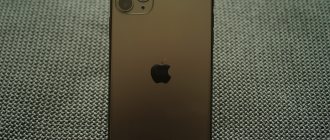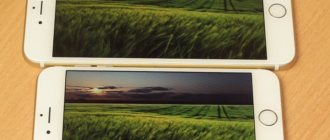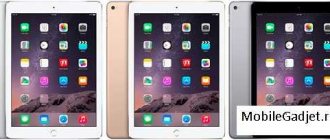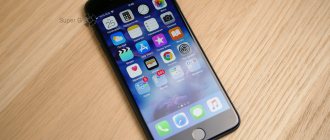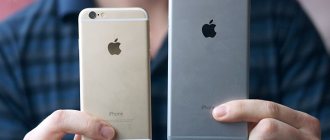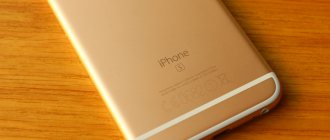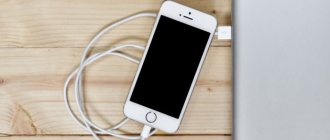The iPhone, one of Apple's most iconic products, has changed a lot this year. The one and only, special, original suddenly ceased to be so. Now there are two of them and you will have to choose which one to buy. The task, I will say right away, is not an easy one, and if you think that you will pick up both new products and immediately understand everything, I have to disappoint you - it’s difficult to decide. On the one hand there is an iPhone with ideal proportions, on the other there is an iPhone for ideal content consumption. Let's try to choose?
Buy an iPhone for 20 thousand cheaper than the market on DamProdam.ru. They change something and even give it away for free.
Before the full review, watch our short video of the iPhone 6 and iPhone 6 Plus - short and most important. Enjoy watching:
Design: iPhone 2G is alive!
The appearance of the last two generations of iPhone has become boring, to put it mildly. Yes, the iPhone 5s looks like a jewel with polished edges, but I’ve been wanting something new for a long time. And we know that the new is the well-forgotten old, which is why the iPhone 6 in your hands is so reminiscent of Apple’s first smartphone.
Rounded edges, a solid piece of aluminum and a comfortable fit in the hand. I’m talking now about both models - iPhone 6 and iPhone 6 Plus, since they are identical in design, the only differences are in size and in some hardware.
The new iPhone could be a real revelation for me, because I've always wanted a true smartphone of the future - a stylish, but no-frills slab of aluminum and glass. This is what the new product would look like if someone in Apple's design department had pulled Jony Ive's cue when he came up with the design of the antenna module in the iPhone 6. The lines you see on the back cover look mediocre. And using the example of thin and neat stripes on the back cover of the Taiwanese flagship HTC One M8, it’s even somehow sloppy and this is strange. Nevertheless, you can get used to this feature (controversial, by the way, this is a matter of taste).
After two days of use, the iPhone 6 already seems familiar. Eyes are already refusing to look at the 4-inch display, hands are reaching for the thin body and fingers want to run across the glass of the new smartphone again. Its edges are slightly rounded, so that the gadget looks and feels like a monolithic piece made of the right materials.
The only caveat is that it is slippery, so I recommend that you think about buying a cover in advance. It seems that Apple accessories are just the thing.
Other noticeable external changes include separate volume control buttons, which are now recessed into the body and can be pressed incredibly clearly. The Power button of the same shape has moved from the top edge to the right side. The thumb of the right hand or the index finger of the left hand rests directly on it. For the first few hours, of course, you continue to fumble around the top edge in search of a button, but over time everything falls into place - this is the only place where you can comfortably reach with your finger and lock/unlock the device.
Regarding the protruding camera module. He didn't bother me at all. Yes, it's noticeable, but the iPhone lies flat on the table and doesn't wobble when you press it on one side. Maybe there is still a minimal, almost imperceptible movement, but in normal use you don’t notice it. I tried to pry at the module with my fingernail, but nothing came of it.
Owner reviews about the screen
The original screen of the iPhone 6 was truly the element through which a fundamental breakthrough was achieved. This is one of the first Apple mobile devices with a display larger than 4". In addition to this, its pixel density is high, and the image on the screen is beyond praise. This is exactly how the owners of the hero of this review characterize the hero from the point of view of picture quality.
Its only drawback is due to the type of matrix used. It boils down to the fact that under certain conditions the color black can turn gray. But this happens so rarely that users don't even notice it.
Screens: Steve was wrong
iPhone 6 Plus, iPhone 6 and iPhone 5s
Immediately after the release of the iPhone 4 (3.5-inch screen), Steve Jobs commented at a press conference on the situation with smartphones equipped with large screens:
It is impossible to control them with your hands, no one will buy them. They're just like Hummer SUVs.
Four years later, his successor Tim Cook introduces two new SUVs. One with a large screen, the second with a huge one.
The screens of the new iPhones have been greatly increased in size compared to previous models. This is striking when you pick up the iPhone 6, and probably shocking when the iPhone 6 Plus falls like a shovel on your fingers. The awkward “hmmm-hmm” quickly changes into surprise - the quality of the display and pictures on them are a cut above those of the iPhone 5s.
The display displays colors perfectly, they are natural - not dull or violently burnt, as in Super Amoled screens, which Samsung is actively promoting in Galaxy smartphones. Viewing angles, I think, are the maximum possible. Just imagine that you turn your iPhone towards you, and the text on the screen remains perfectly readable. Yes, thanks to the new polarizer film in the iPhone 6/6 Plus, the display behaves much better in the sun than the iPhone 5s.
With the screen of the iPhone 6 Plus, the situation is exactly the same as with the iPhone 6. If you do not take into account that its dimensions will seem extremely large for the user of the “five”. The iPhone seems very unusual with such a screen and, it seems to me, that’s what Apple intended. This is practically a new device that can “eat up” some iPad mini users and launch the process, predicted by many, of turning iPad tablets into full-fledged computers with touch screens.
- iPhone 6: 4.7 inches, 1334×750 pixels
- iPhone 6 Plus: 5.5 inches, 1920x1080 pixels
Is a resolution of 1920 by 1080 pixels enough for a 5.5-inch screen? With your head. And don’t believe those who recommend urgently switching to QuadHD displays, which are already available in some Android smartphones - LG G3 and Samsung Galaxy Note 4. The human eye can only distinguish pixels at up to 300 ppi, while in the iPhone 6 Plus it is a whopping 401 pixels per inch. The performance race has never led to anything good. The iPhone compared to top Android gadgets is a prime example of this.
Advantages and disadvantages of the iPhone 6
The dimensions of the Apple iPhone 6 are 67 mm wide, 138.1 mm long and 6.9 mm thick. With such dimensions it is convenient to operate the device with one hand. In addition, the weight of the device is about 129 g. Even if you operate the device with one hand, its weight is almost not felt.
If we evaluate the overall ease of use of the phone taking into account the size and weight, then there will be no problems with everyday use.
The smartphone is equipped with a 2-core Apple A8 APL1011 processor, which is made at 20 nm. technical process.
The smartphone has only 1 GB. RAM, which is quite small. Instances of low RAM will occur regularly, so even when using light applications you will experience instability in operation.
The device's data storage capacity is 16 GB, and while this is enough for photos, it may not be enough for video shooting and a large number of games.
Since the phone does not support SD cards, you need to ensure that the device has enough memory for your needs.
The iPhone 6 has a display diagonal of 4.7 inches. The display is large enough that you will rarely have problems with its size. However, this display is not suitable for writing long texts.
The smartphone has a high-end display and any graphic content you display on it, including videos and games, will be displayed clearly.
The main camera of the phone has 7.99 megapixels, which should be enough in most cases. However, you may be slightly unsatisfied with the quality of the photos.
Also, the smartphone has a 1.23 megapixel front camera, which is low. If you care about the quality of your photos, you should consider a higher-end smartphone.
The battery capacity of the Apple iPhone 6 is 1810 mAh, which is a common capacity indicator. Compared to other smartphones, the battery life of the Apple iPhone 6 is average. You don't have to worry about anything during daily use. However, if you spend time surfing the internet or playing games, you might be a little underwhelmed by the battery life.
Iron: simply better
It is not customary to talk about technical characteristics in the world of Apple mobile devices. Where have you heard users of different generations of iPhones talk about processors, RAM and, excuse me, overclocking? But you want this, right? Then here is a comparison of two smartphones in the Geekbench iOS application to calculate processor speed:
Yes, the iPhone 6 and iPhone 6 Plus are currently the most powerful smartphones Apple has ever created. They run on the same new generation Apple A8 processor with a clock speed of just (for the modern smartphone world) 1.4 GHz. Feel free to add the M8 coprocessor here, which helps you clearly count the number of steps taken and calories burned. RAM - 1 GB, same as in iPhone 5s. But was it ever not enough? This isn't a Mac.
What's the result? My overall impression is that iOS 8 runs slightly faster on the iPhone 6/6 Plus than on the iPhone 5s. The difference is very small, literally minimal, but it is there. This is traditional Apple magic, when you pick up a new iPhone, after which you no longer want to use the “old” one.
Yes, games load a moment faster, the multitasking menu with thumbnails appears in a second, but this is far from the main feature of the new iPhones. Oh yes, if you are confused by the operation of iOS on a 5.5-inch display with Full HD resolution, I will say that there are no problems. Both smartphones work almost identically, if you do not take into account minor slowdowns in literally a few games (Real Racing, this one is the most). This is an optimization question that developers need to ask. I played Asphalt 8, updated to work with direct access technology to GPU Metal, Modern Combat 5 and the graphics, I admit, were impressive.
Battery: powerful, but lacking in innovation
I’ll be honest, it’s not easy to understand in two days how the batteries behave in new Apple smartphones. No, it's not even possible. I can say one thing for sure - my iPhone 5s, which I have been using for about 8 months, has held its charge several times worse during this time than both new items that were lying next to each other. Yes, the battery in the iPhone 5s could get “tired” during this period of operation, but the fact remains that in the evening my smartphone lay down to rest with 0% charge, while the iPhone 6 had 30% left, and Plus, it seems, was ready to work even before lunch the next day. It had about 55% charge left. Worthy.
The numbers, which can be found on Apple.com, speak for themselves. The iPhone 6 can last 250 hours in standby mode, while the iPhone 6 Plus can last 384 hours in a locked state. The younger model will be able to show you about five films of medium length, the older one - all seven. The indicators are not bad, but not revolutionary. I would really like innovations in mobile batteries, but not this year, unfortunately. Nowadays mobile photography is in fashion and you will definitely like everything here.
Cameras: Where are my megapixels?
There is none of them. More precisely, there are as many of them as in last year’s model. And in the year before last, and even in the iPhone 4S. You were deceived, set up and pushed with outdated hardware at an exorbitant price. You are wrong.
iPhone 6
iPhone 6 Plus
Indeed, the iPhone 6 and iPhone 6 Plus have an 8-megapixel camera with an ƒ/2.2 aperture, but with new lenses. One of the most impressive technologies in these cameras is Focus Pixels. This is a phase focusing system that seriously reduces focusing time when the camera moves. The principle of its operation is as follows: you take your iPhone out of your pocket, open the Camera application and begin frantically photographing several objects around you at once, abruptly changing the position of the smartphone. There is no additional focusing, it seems that the camera is reading the image around you immediately after you take out the phone. Forget tap-to-focus—iPhone does it for you.
iPhone 6
iPhone 6 Plus
The quality of the images is at a high level, with a minimum of soapy scenes when photographing indoors, this is truly impressive. This is especially true of the iPhone 6 Plus with its optical stabilization system, which can take stunning photos. If you have direct hands, you can create real masterpieces, print them and hang them on the wall.
iPhone 6
iPhone 6 Plus
Apple also worked on video quality. The cameras in the two new products can shoot FUllHD video at 60 frames per second, while slow-mo videos can now be made in two formats - 120 and 240 frames per second. Together with cinematic stabilization during video shooting, we get the most desired mobile video camera for a real video maniac.
Settings
In the settings - messages, calendar, photo, camera and “Passbook”. You can enter your boarding passes, movie tickets, coupons and club cards, which will be displayed even on the locked screen. Starting from version 8.1 - credit cards. The system has been operating since 2012 and is supported in many countries, including Russia.
There is a Health app. Here data is collected, how much you walked, as well as data from third-party applications that can do even more. You can enter observation dates. You can keep absolutely any statistics for yourself. Starting from the amount of sugar in the blood, etc.
Motion type M8 works great and reads your movements even better. What I didn’t like was the operation of the new gyroscope and accelerometer, which get stuck, and the phone has to be turned twice to change the screen orientation. Previously, everything worked like clockwork.
There are watches and maps that few people still like. Video player, reminders. A kiosk where you can browse newspapers and magazines by subscription from the App Store. "Reader" IBooks, notes.
Standard set “Weather”. “Promotions”, “Game Center”, where you can compete on points in games with your friends. App Store for downloading applications and videos from third-party devices. “Face Tim” for video and audio calls with owners of other Apple equipment.
Calculator with normal functionality, “Podcasts”, compass. "Tips" where you can learn new functions. Contacts. Next - “Numbers” using Excel type. "iMovie" for video processing. "Pages" like Word. "Keynote" for creating presentations like in Power Point. "Garage Band" for creating music and mixing it. Dialer, Safari browser and Music application.
Read also Review and characteristics of Samsung Galaxy s3 mini (Galaxy 3 mini)
Features of iPhone 6 Plus: mini iPad mini
It’s not for nothing that I said above that the iPhone 6 Plus does not seem like just a new smartphone or the second model of this year. This is something new that may soon affect other Apple devices. For example, on the iPad mini. I sincerely don’t understand why a user needs a small tablet with a 7.9-inch screen when there is an iOS smartphone with a 5.5-inch display that is always in their pocket. It is simply created for consuming content in huge quantities - you want to watch movies, play action games and arcade games, surf the Internet through Safari or, for example, do video editing through the iMovie application. This is the ultimate gadget for the active user who is “on the edge.” That is, it is really huge for a phone, but at the same time it is so convenient during use. In addition, Apple took care of the pioneers and made some changes to iOS 8 that are only available on the iPhone 6 Plus.
First, it's landscape mode, like on the iPad. The desktop, icons, content - everything is in a horizontal position. This feature is activated in Settings -> Display and brightness -> View. Here we select the normal mode, where work in a horizontal position is available by default.
If you select the “Zoom” mode, all icons and text will become slightly larger. It’s promising, but it requires support from developers who optimize their software to work in this mode.
Another point is changes in the location of some interface elements in standard applications. For example, Mail and Messages have dual-screen mode enabled, just like on the iPad. This also includes the supposedly improved keyboard, to which quick access buttons for the “Copy, Cut, Paste” functions have been moved, but you need to seriously get used to them. It feels like the system is not perfected. Either the iPhone 6 Plus was released ahead of schedule, or it was simply overlooked.
Unlike other manufacturers of large smartphones, Apple has done a good job of making them more convenient. While competitors are introducing complex control schemes for large screens into interfaces, Cupertino is simply adding one, but useful, function. Double tapping (not pressing) the Home button lowers the entire interface of any application so that you can reach the status bar with one finger. Simple and convenient.
There is also a problem with the display of some applications. No, I didn’t notice any pixels, but the software that looked normal on the iPhone 5s screen now looks strange on the 5.5-inch Godzilla. There is a lot of space on the screen, but the interface elements are stretched and look somehow awkward or even clumsy. I think developers are already aware of this nuance and are already reviewing the interfaces of their programs.
iPhone 6S and iPhone 6S Plus Features Overview
Versions with the letter S came out much later than the simple “sixes” and were a more technologically advanced and innovative product.
As you can see, the design has changed little compared to 6
In particular, the characteristics of the iPhone 6S phone used new hardware, new software, and the available colors were slightly changed. One of the main innovations was the 3D Touch screen, which responded to touch force. The fingerprint scanner has received a second generation.
Memory, processor and iOS 9 operating system
The processor, the main characteristic of the iPhone 6S, was installed in both new products with a more modern one - A9. It was also built on a 64-bit architecture, had two cores, but with a higher frequency - 1.8 GHz.
A9 is more economical and productive compared to A8
The amount of RAM has also been increased to 2 GB. The gradation of its memory was mainly in two versions: 32 GB and 128 GB.
The standard operating system upon purchase is iOS 9. It can be upgraded to 11.2.6.
Display and multimedia capabilities
The ratio of screen sizes and resolutions of the two smartphones 6S and 6S Plus remained within the logic of its predecessor. The “Plus” received a 5.5-inch screen and a resolution of 1920 by 1080, while the regular 6S had 4.7 inches and 1334 by 750. The technology used in the screens remained the same - IPS.
Communications and interfaces iPhone 6S and iPhone 6S Plus
S-models received new modems and transmitters. Operating frequency ranges up to 4G remained the same for iPhone 6 and 6 Plus. But LTE has already become noticeably faster. Category 6 networks with a bandwidth of 300 Mbit/s are used here.
Wi-Fi standards are represented by all known ones, up to 802.11 ac. The module can operate at two frequencies - 2.4 GHz and 5 GHz. Navigation includes GPS, GLONASS and auxiliary A-GPS.
Battery and other functions
The S batteries are different, which is not surprising - after all, their consumers are also different. The simple version has a 1715 mAh battery, and the Plus version has a 2750 mAh battery. In fact, the developers only reduced the battery charge in new gadgets, which affected their autonomy. It is almost impossible to last all day with a full battery while actively using most functions without additional recharging.
Different pressing forces can be used to call up different functions.
But the 3D Touch function pleased fans. The introduction of pressing force has opened up new horizons for using all the functions of a smartphone. Now it has become possible to perform several different actions with essentially the same movement. So-called quick actions have also appeared - that is, by pressing harder on the application icon, you can use certain functionality without going into it. This turned out to be a very convenient innovation, although it took a little getting used to.
About not the most important: boxes and kit
Please note the changes in the appearance of the boxes from the new iPhone 6 and iPhone 6 Plus. Now they are completely white without any pictures, except for the model name on the side. The silhouette of a smartphone is embossed on the lid of the box. It looks unusual and unusual. With the kit, everything is much simpler - inside the box everything is the same as what came with the iPhone 5s: EarPods, a Lightning cable, a charger and a bunch of paper materials with a “clip” for opening the SIM slot inside.
Box and colors
Let's start, according to tradition, with the box. From the outside, this box does not create the “wow” effect that previous models caused. The box is simply white with a small gadget-shaped bulge on top. On the sides there is an “apple” and the inscription “iPhone”. The back of the box describes the model that is inside.
iPhone 6 is available in three colors: space gray, silver and gold. Regardless of the color of the phone, the boxes are exactly the same. In general, boring.
When you open the box for the first time, you will find a gadget wrapped in film and an envelope with some information, a warranty card, Apple stickers and a device that removes the SIM card. And at the very bottom of the box are “Air phone” headphones, a power adapter and a “lighting” cable. In general, standard equipment.

